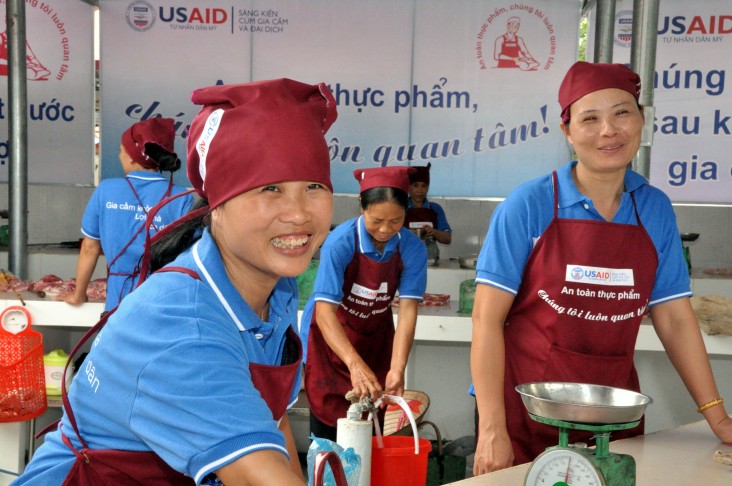
Vietnam is in a relatively high-risk region for emerging infectious diseases (EIDs), including zoonotic diseases arising from the interaction of humans, livestock, wild animals and ecosystems. Examples of EIDs impacting Vietnam in recent years include SARS in 2003, avian influenza A (H5N1) from late 2003 to the present, influenza A (H5N6), and the pandemic strain of influenza A(H1N1) in 2009. Risky practices related to bio-security of livestock and wildlife farming, and trade and consumption of animal products remain a strong concern and will require a long-term effort. USAID has supported strengthening of country systems to effectively address these and other emerging and transnational health threats in both humans and animals.
Influenza
While the number of reported H5N1 outbreaks has decreased substantially in recent years, outbreaks of the virus in poultry and sporadic human cases continue to occur. Influenza A(H7N9) virus in humans and animals has circulated annually in China since 2013, and provides another example of a potentially serious threat to public health and economic development.
Since 2005, USAID has worked nationally and in high-risk provinces in the Red River and Mekong River deltas to strengthen national and regional preparedness, planning and multi-sectoral coordination to prevent transmission of influenza and other viruses from animals to humans. Working closely with the Government of Vietnam, we promote early detection and warning of avian and human influenza outbreaks through improvements in national and community-based surveillance, with a focus on the animal-human-ecosystem interface under a One Health platform and development of quick-response capacity. USAID has supported training, an upgraded animal health information system, provision of equipment and commodities relevant to avian and pandemic influenza, enhanced laboratory diagnostic capacity, and the sharing of best practices and lessons learned.
Emerging Pandemic Threats
USAID launched the Emerging Pandemic Threats 2 (EPT-2) program in 2014, which builds on the successes of the Agency’s programs in disease surveillance, training and outbreak response. The EPT-2 program expands the operational platforms, institutional partnerships and knowledge base developed over the past decade by USAID’s EPT-1 and the Avian Influenza (AI) portfolios to pre-empt or combat, at their source, newly emerging diseases of animal origin that could threaten human health. EPT-2 will directly improve the capacity of more than 20 focus countries in Africa and Asia to prevent, detect and respond to infectious disease threats, which are key objectives of the Global Health Security Agenda (GHSA) and the International Health Regulations. Under GHSA, and with the support of USAID and other partners, Vietnam is taking a leading global role in addressing zoonotic diseases and in expanding the scope and function of emergency operations centers.
USAID’s EPT-2 program focuses on helping countries detect viruses with pandemic potential, improve laboratory capacity to support surveillance, respond in an appropriate and timely manner, strengthen national and local response capacities, address the emerging threat of antimicrobial resistance, and educate at-risk populations on how to prevent exposure to dangerous pathogens. The EPT-2 program is managed by USAID with technical collaboration from the U.S. Centers for Disease Control and Prevention (CDC), the World Health Organization (WHO) and the Food and Agriculture Organization of the United Nations (FAO). In addition, USAID awarded three new projects in 2014: Predict-2, One Health Workforce, and Preparedness & Response, to provide additional technical support to developing countries.
Since 2005, USAID has provided over $75 million in assistance and technical support to Vietnam through implementation partners, in close cooperation with the Ministry of Agriculture and Rural Development and the Ministry of Health.
See our Project List | See our Project Map
KEY GOVERNMENT OF VIETNAM PARTNERS
Success Stories
- Vietnamese Duck Farmers Earn More While Preventing Avian Influenza
- Hygienic Poultry Slaughtering Curbs Bird Flu in Vietnam
- Vietnam Tightens Noose on Emerging Pandemic Threats
Photo Albums
- USAID supports model duck farms and biosecurity standards to prevent spread of avian influenza (May 2014)
- USAID Donates Personal Protective Equipment to Vietnam's Ministry of Agriculture and Rural Development (November 2013)
- Handover Ceremony Hoa Mac Market Ha Nam (October 2012)
- U.S. Provides Protective Gear to Help Prevent Disease Outbreaks (October 2012)
- USAID Supports Animal Virus Detection Laboratory Training (September 2012)
- Disease Risk Reduction in Dong Ha Poultry Market, Quang Tri (December 2011)
- USAID Contributes Protective Gear for Infection and Disease Outbreak Control (September 2011)








Comment
Make a general inquiry or suggest an improvement.